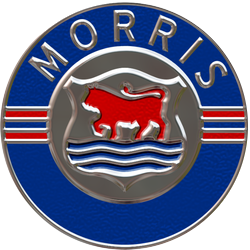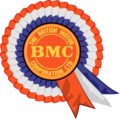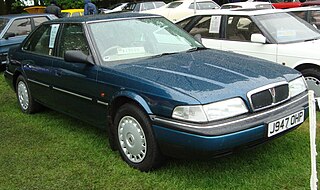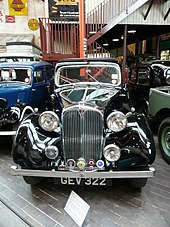
MG is a British automotive marque founded by Cecil Kimber in the 1920s, and M.G. Car Company Limited was the British sports car manufacturer that made the marque famous. Best known for its open two-seater sports cars, MG also produced saloons and coupés, with engines up to three litres in size and 3.5 L in the case of the MGB GT V8. The marque is now owned by Chinese state-owned automaker SAIC Motor Corporation Limited.

Morris Motors Limited was a British privately owned motor vehicle manufacturing company formed in 1919 to take over the assets of William Morris's WRM Motors Limited and continue production of the same vehicles. By 1926 its production represented 42 per cent of British car manufacture—a remarkable expansion rate attributed to William Morris's practice of buying in major as well as minor components and assembling them in his own factory. Largely self-financed through his enormous profits, Morris did borrow some money from the public in 1926, and later shared some of Morris Motors' ownership with the public in 1936. The new capital was then used by Morris Motors to buy many of his other privately held businesses.
The automotive industry in the United Kingdom is now best known for premium and sports car marques including Aston Martin, Bentley, Caterham Cars, Daimler, Jaguar, Lagonda, Land Rover, Lister Cars, Lotus,MG, McLaren, Mini, MOKE, Morgan, Rolls-Royce and TVR. Volume car manufacturers with a major presence in the UK include Nissan, Toyota, BMW, and Vauxhall Motors. Commercial vehicle manufacturers active in the UK include Alexander Dennis, Dennis Eagle, IBC Vehicles, Leyland Trucks, TEVVA and London Electric Vehicle Company.

MG Rover Group was a British carmaker that existed between 2000 and 2005. It was the last domestically owned mass-production car manufacturer in the British motor industry. The company was formed when BMW sold the car-making and engine manufacturing assets of the original Rover Group to Phoenix Venture Holdings in 2000.

The Rover Company Limited was a British car manufacturing company that operated from its base in Solihull in Warwickshire. Its lasting reputation for quality and performance was such that its first postwar model reviewed by Road & Track in 1952 was pronounced finer than any but a Rolls-Royce. Rover also manufactured the Land Rover series from 1948 onwards, which spawned the Range Rover in 1970, and went on to become its most successful and profitable product — with Land Rover eventually becoming a separate company and brand in its own right.

The British Motor Corporation Limited (BMC) was a UK-based vehicle manufacturer, formed in early 1952 to give effect to an agreed merger of the Morris and Austin businesses.

The Austin Motor Company Limited was an English manufacturer of motor vehicles, founded in 1905 by Herbert Austin in Longbridge. In 1952 it was merged with Morris Motors Limited in the new holding company British Motor Corporation (BMC) Limited, keeping its separate identity. The marque Austin was used until 1987 by BMC's successors British Leyland and Rover Group. The trademark is currently owned by the Chinese firm SAIC Motor, after being transferred from bankrupt subsidiary Nanjing Automotive which had acquired it with MG Rover Group in July 2005.

British Leyland was an automotive engineering and manufacturing conglomerate formed in the United Kingdom in 1968 as British Leyland Motor Corporation Ltd (BLMC), following the merger of Leyland Motors and British Motor Holdings. It was partly nationalised in 1975, when the UK government created a holding company called British Leyland, later renamed BL in 1978. It incorporated much of the British-owned motor vehicle industry, which in 1968 had a 40% share of the UK car market, with its history going back to 1895. Despite containing profitable marques such as Jaguar, Rover, and Land Rover, as well as the best-selling Mini, BLMC had a troubled history, leading to its eventual collapse in 1975 and subsequent part-nationalisation.
The Rover Group plc was the British vehicle manufacturing conglomerate known as "BL plc" until 1986, which had been a state-owned company since 1975. It initially included the Austin Rover Group car business, Land Rover Group, Freight Rover vans and Leyland Trucks. The Rover Group also owned the dormant trademarks from the many companies that had merged into British Leyland and its predecessors such as Triumph, Morris, Wolseley, Riley and Alvis.

The Triumph Motor Company was a British car and motor manufacturing company in the 19th and 20th centuries. The marque had its origins in 1885 when Siegfried Bettmann of Nuremberg formed S. Bettmann & Co. and started importing bicycles from Europe and selling them under his own trade name in London. The trade name became "Triumph" the following year, and in 1887 Bettmann was joined by a partner, Moritz Schulte, also from Germany. In 1889, the businessmen started producing their own bicycles in Coventry, England.

Vanden Plas is the name of coachbuilders who produced bodies for specialist and up-market automobile manufacturers. Latterly the name became a top-end luxury model designation for cars from subsidiaries of British Leyland and the Rover Group, it was last used in 2009 to denote the top-luxury version of the Jaguar XJ (X350).

The Metro is a supermini car, later a city car that was produced from 1980 to 1998, first by British Leyland (BL) and later by the Rover Group. It was launched in 1980 as the Austin Mini Metro. It was intended to complement and eventually replace the Mini, and was developed under the codename LC8. The Metro was named by What Car? magazine as "Car of The Year" in 1983 as an MG, and again as the Rover Metro in 1991.

The Rover 800 series is an executive car range manufactured by the Austin Rover Group subsidiary of British Leyland, and its successor the Rover Group from 1986 to 1999. It was also marketed as the Sterling in the United States. Co-developed with Honda, it was a close relative to the Honda Legend and the successor to the decade-old Rover SD1.
The Austin Rover Group was a British motor manufacturer. It was created in 1982 as the mass-market car manufacturing subsidiary of British Leyland (BL). Previously, this entity had been known as BL Cars Ltd which encompassed the Austin-Morris and Jaguar-Rover-Triumph divisions of British Leyland. After a major restructuring of BL's car manufacturing operations, Jaguar regained its independence whilst the Triumph and Morris marques were retired. The new, leaner car business was rechristened as the Austin Rover Group and focused primarily on the Austin and Rover marques. The Morris and Triumph marques continued briefly within ARG until 1984 when both were dropped.

The Longbridge plant is an industrial complex in Longbridge, Birmingham, England, currently leased by SAIC as a research and development facility for its MG Motor subsidiary. Vehicle assembly ended in 2016.

The Rover SD1 is both the code name and eventual production name given to a series of executive cars built by the Specialist Division, and finally the Austin Rover division of British Leyland from 1976 until 1986, when it was replaced by the Rover 800. The SD1 was marketed under various names. In 1977 it won the European Car of the Year title.
1986 in motoring includes developments in the automotive industry throughout 1986 by various automobile manufacturers, grouped by country. The automotive industry designs, develops, manufactures, markets, and sells motor vehicles.

Plant Oxford located in Cowley, southeast Oxford, England, is a BMW car assembly facility where Mini cars are built. The plant forms the Mini production triangle along with Plant Hams Hall where engines are manufactured and Plant Swindon where body pressings and sub-assemblies are built.

Solihull plant is a car manufacturing factory in Lode Lane, Lode Heath, Solihull, UK, owned by Jaguar Land Rover. The plant sits on a 300-acre (120 ha) site and employs over 9,000 people in manufacturing.
The Austin Drawing Office was the design and engineering department of the British Motor Corporation. From the early 1950s, the resulting projects of the office were known by the initials ADO. The numbers were assigned to vehicle and engineering projects, some resulting in production models. The ADO numbering system continued well beyond BMC's absorption into British Leyland, who continued to use the convention until the late 1970s.

























